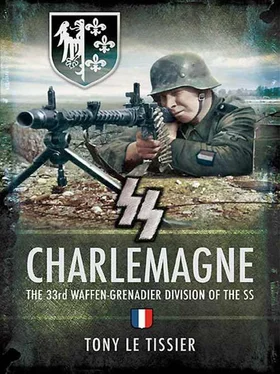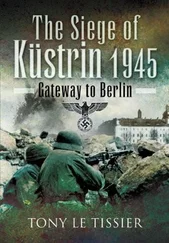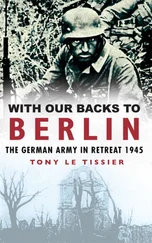In turn, Zhukov decided to launch an attack toward Stettin on 19 February, using the 2nd Guards Tank Army, the 61st Army and the 7th Guards Cavalry Corps. Two corps of the 61st Army surrounded Arnswalde while one division went in to clear the town in bitter street fighting, so Zhukov temporarily called off the operation and switched to the defensive.
22 February 1945
The first train load of the Charlemagne arrived at Hammerstein station on the Pomeranian boundary with East Prussia at 0200 hours on 22 February. This was unexpected, for when the train carrying the Divisional Headquarters had stopped at Gollnow, near Stettin, at about 1700 hours the previous day, Brigadier Puaud, SS-Colonel Zimmermann, Captain Renault and Officer-Cadet Platon had left the train and driven on to Rummelsburg, only to discover upon arrival that the train carrying the main body had meanwhile been diverted to Hammerstein. Now allocated to the 11th SS-Panzer Army, the Division was to regroup at Hammerstein Camp, where it would receive additional arms and equipment and have a week to prepare before going into the line.
However, back in Moscow after the distractions of the Yalta Conference, between 17 and 22 February the Soviet High Command issued fresh instructions to Marshals Zhukov and Rokossovsky calling for a combined attack that would split the Pomeranian group of German forces in half and then fan out to clear the area. In pursuance of these instructions, Rokossovsky launched his 2nd Byelorussian Front in an attack on 24 February in which the 3rd Guards Tank Corps and 19th Army spearheaded a northerly thrust to the Baltic coast near Köslin, while the main body did a right hook toward Danzig and Gotenhafen.
It was calculated that the German forces defending Pomerania were facing an enemy superiority of 1 to 3–5 in infantry, 1 to 2–4 in tanks and 1 to 4–6 in artillery.
24 February 1945
At Hammerstein Camp at dawn on 24 February, a strong artillery bombardment could be heard and seen some 15km to the southeast as the Soviets conducted an artillery preparation. Five divisions of the Soviet 19th Army had launched an attack on the 32nd Infantry Division between Marienfelde and Konitz.
That same morning Major Emile Raybaud arrived by train with the 58th Regiment’s headquarters and Captain Emile Monneuse’s 1st Battalion.
Consequent upon the Soviet attack, the Charlemagne was now assigned to the 2nd Army’s XVIIIth Mountain Corps, commanded by Lieutenant-General Hans Hochbaum. Until the arrival of the Charlemagne , this corps, which had no mountain troops, consisted of only the 32nd Infantry Division and the 15th Waffen-SS-Grenadier Division of Latvians, and was responsible for a 45km front, for which the Charlemagne came as a welcome reinforcement. The Latvians had their divisional headquarters in the village of Krummensee, with their two regiments covering the western flank along the Kuddow River through the town of Landeck and then facing southwards along the line of the Dobrinka River as far as the village of Rosenfelde. The 32nd Infantry had their headquarters at Stolzenfelde, north of Schlochau, and covered the line eastwards, north of Preussisch Friedland to Konitz.
Both divisions were of excellent fighting quality, the Latvians seeking revenge for the Russian invasion of their country, while the 32nd Infantry had been raised in Pomerania and was literally defending its home ground, but both had already been engaged with the enemy for a month and had suffered severe casualties.
During the course of the morning, a conference was held at the camp with SS-Major-General Krukenberg, Brigadier Puaud and the two regimental commanders, Captains Raybaud and Victor de Bourmont, attending. The front held by the Latvians had been penetrated and the Division had just received orders to plug the breach. The command intention was to form a stop line facing east in the area between Hammerstein and Schlochau, with the front supported by the Haaken River in the south and southwest and by the Kramsker See and Gross Ziethener See lakes in the north.
With only three battalions available, the orders for the move were given out immediately and took place at about midday as follows:
a) The 1st/57th (Lieutenant Henri Fenet) towards Heinrich swalde and Barkenfelde.
b) The 2nd/57th and HQ 57th Regt (Captain de Bourmont) towards Geglenfelde. (For tactical reasons the 57th Regiment was provisionally attached to the 32nd Infantry Division and was to hold the prescribed line of the front for about 7km running from south of Heinrichswalde to east of Barkenfelde. The right wing of the 32nd Infantry Division extended as far as Bärenhutte railway station.)
c) The 1st/58th (Captain Emile Monneuse) and HQ 58th Regt (Captain Emile Raybaud) to Barenhutte as the divisional reserve.
However, it should be noted that not only was the Division incomplete, but it was going into action with only those items, including ammunition, that it had brought with it. There were no radios and only a few maps. The military installation at Hammerstein was empty of all military stores as a result of its previous use as a prisoner-of-war camp.
Fenet’s 1st/57th left its temporary position and advanced towards Heinrichswalde, which it was to occupy and defend as a firm base of operations, but its march was delayed by the very poor state of the road. At times the carts carrying their heavy weapons and ammunition sank up to their hubs in the mud through which the troops had to march, while refugees fleeing in the opposite direction forced them to the side of the road. On the way Lieutenant Fenet learned that the Russians had broken through and were also heading for Heinrichswalde. The battalion immediately prepared to encounter the enemy.
Towards 1900 hours, as night fell, Second-Lieutenant Counil’s leading 3rd Company was approaching Heinrichswalde when it was met by a hail of fire. The enemy had just occupied the village without a fight, for the front in this sector appeared to have been completely abandoned. Second-Lieutenant Counil estimated the enemy effectives no more than a company, so Lieutenant Fenet decided to attack in strength.
The 3rd Company would pin down the enemy from the south-west, the 1st Company would surround the village from the southeast and Lieutenant Bartholomei’s 2nd Company from the northwest. During the mortar preparation by Staff-Sergeant Couvreur’s 4th Company, the 2nd Company was to establish contact with the 2nd Battalion on the left, but none of the patrols sent out were able to make contact with anyone in that direction. The mortar preparation proved of short duration, as the ammunition soon ran out.
The 1st and 3rd Companies attacked, while the 2nd Company swept the ground to the east with automatic weapons, reducing the enemy resistance in the village. But the enemy machine guns proved judiciously well placed and the enemy effectives were now estimated at being a battalion. Flares and a clear night prevented further progress.
The 3rd Company advanced at the cost of very heavy losses, Second-Lieutenant Counil being killed, and rapidly reached the centre of the village, which it occupied and began to clear. When the 1st Company tried to advance, it was quickly checked by violent fire coming from heavy weapons. There was some hesitation, and a tentative flanking movement had no more success than the direct attack. The 2nd Company could not move, as enemy fire had it pinned down and the enemy could not be dislodged from this part of the village.
At this moment, the Soviets launched a violent counterattack to retake the village. The 3rd Company, reinforced by Battalion HQ, and supported by the fire of the other companies, intervened and neatly stopped the Russians, who resumed their attack several times, being rebuffed each time. Eventually Lieutenant Fenet was thinking of surrounding Heinrichswalde left and right with his 1st and 2nd Companies in a concentric attack, when the 1st Company signalled that Russians were advancing northwards unopposed between the Schönwerder and Peterswalde roads. The 2nd Company also reported that strong Russian infantry formations were advancing non-stop on Barkenfelde.
Читать дальше












